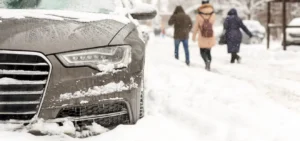Delivering precision winter gritting isn’t a dark art – it’s based on careful planning, weather data and detailed processes.
Data drives our precision winter gritting
Data is central to all winter operations at OUTCO, as daily road safe temperatures (RST) forecasts are obtained at midday. Visits are triggered for an area when the temperature is around 0-degree Celcius and jobs are dispatched to the operators’ phones via our bespoke Nimbus system.
- Gritting jobs are split by either precautionary gritting, were salt is applied at 40 gsm (grams per square metre); or efficacy gritting, when 15-40 gsm is used for cost purposes and to minimise the environmental impact.
- Ensure the optimum driving speeds for controlled salt spreading. Driving at the wrong speed will impact on spread rates.
- We use the right salt to meet the demands of the British standards, any sub-standard material will cause problems to the job completion and equipment. At OUTCO we predominately use white winter gritting salt (marine salt).
- Our operators receive data to spread salt at the right time. Winter gritting after the weather will result in unnecessary risk and increase the volume of salt being used. Optimum time to spread salt is within a 2-hour window so the marine salt can dissolve and be most effective.
Fully trained OUTCO winter operators
Ahead of every winter season, we ensure that all new winter gritting operators undergo comprehensive winter training and rigorous practical assessments via our OUTCO Training Academy.
A typical winter gritting routine
- 16:35 – Job dispatch list is completed and verified
- 18:00 – Response received for all operators to confirm receipt of nights service list on their smartphone
- 18:05 – Investigate any operators that have failed to respond
- 18:00 – 06:00 – Operators commence service delivery and job completion is monitored on a live basis and service data returned to us in real time as the jobs are completed, with any issues being reported to site on a live basis
- 22:00 – Inspection lists dispatched to assistant regional managers to conduct site checks
- 02:00 – Site checks completed, and data returned to us
- 09:00 – Service reports emailed to client sites.
Gritting walkways manually by hand
Walkways are best serviced manually with an operator using a bucket and scoop, or using a push spreader, quad bike or drop spreader. For all winter gritting purposes, white marine salt is used conforming to BS 3247:1991.
Snow & ice clearance when needed
From our weather data we know when winter gritting is not going to be enough, and our operators are thoroughly trained in snow and ice clearance.
We undertake snow or ice clearance to pedestrian areas (walkways etc) when ice or 2 cm+ of snow is present at the time of the gritting visit. This applies to key pedestrian walkways, to and from car parks, and fire exits.








